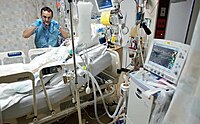
Photo from wikipedia
DOI:10.1097/MCC.0000000000000807 The gastrointestinal system is complex because of the different organs involved and the multitude of functions it covers, as well as the complex anatomy and intricate pathophysiology that remains… Click to show full abstract
DOI:10.1097/MCC.0000000000000807 The gastrointestinal system is complex because of the different organs involved and the multitude of functions it covers, as well as the complex anatomy and intricate pathophysiology that remains incompletely understood. Moreover, the not so straightforward interactions between different organs further complicate both diagnostics and therapies in the ICU. In the past years, there have been continued and significant advances in our understanding of the pathophysiology as well as clinical management of gastrointestinal problems and diseases, and these are the focus of the current issue of Current Opinion in Critical Care. New insights are gained at a rapid pace in our understanding of gut dysfunction, as well as the role of ultrasound in the management gastrointestinal disorders. Chapple et al. (pp. 141–146) cover the obvious relation between gut function and poor outcomes in critical care, and hence the importance of evaluating gut function and dysfunction. New biomarkers have been introduced but still require more study. From a patient management perspective, the focus is now on delivering adequate enteral nutrition to the gut. Point of care ultrasound (POCUS) has revolutionized the diagnostic approach for many disorders in the emergency department and ICU. While the chest is often the primary target for POCUS, Wong et al. (pp. 147–156) nicely demonstrate that also this is also relevant in the abdomen and the gastrointestinal tract. Not only the standard techniques can be helpful but also contrast enhanced ultrasound, elastography and color Doppler techniques have their application. This will assist in evaluating the gastrointestinal tract and its perfusion, and help physicians in specific situations for example managing patients after trauma or patients with chronic liver disease. Two articles in this issue also deal with hot topics that have challenged and will force us to change our understanding of abdominal conditions’ pathophysiology. The microbiome and how its changes during critical illness are connected to many disorders in the critically ill patient is probably the most spectacular one. Miniet et al. (pp. 157– 163) focus on the relation between the gut
Journal Title: Current Opinion in Critical Care
Year Published: 2021
Link to full text (if available)
Share on Social Media: Sign Up to like & get
recommendations!